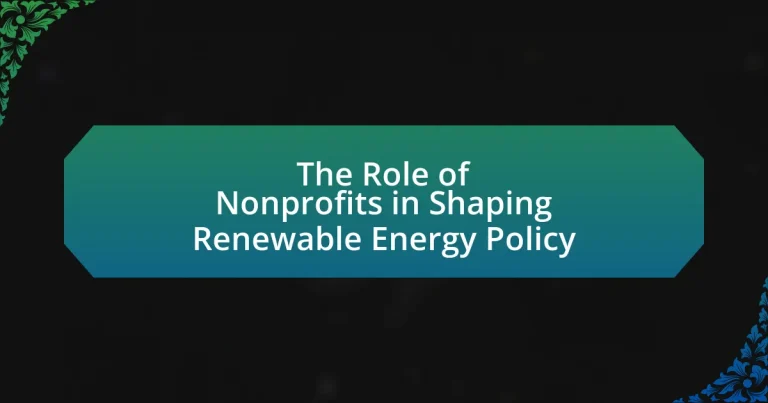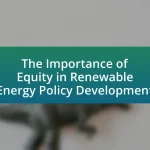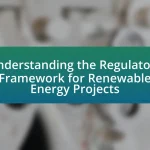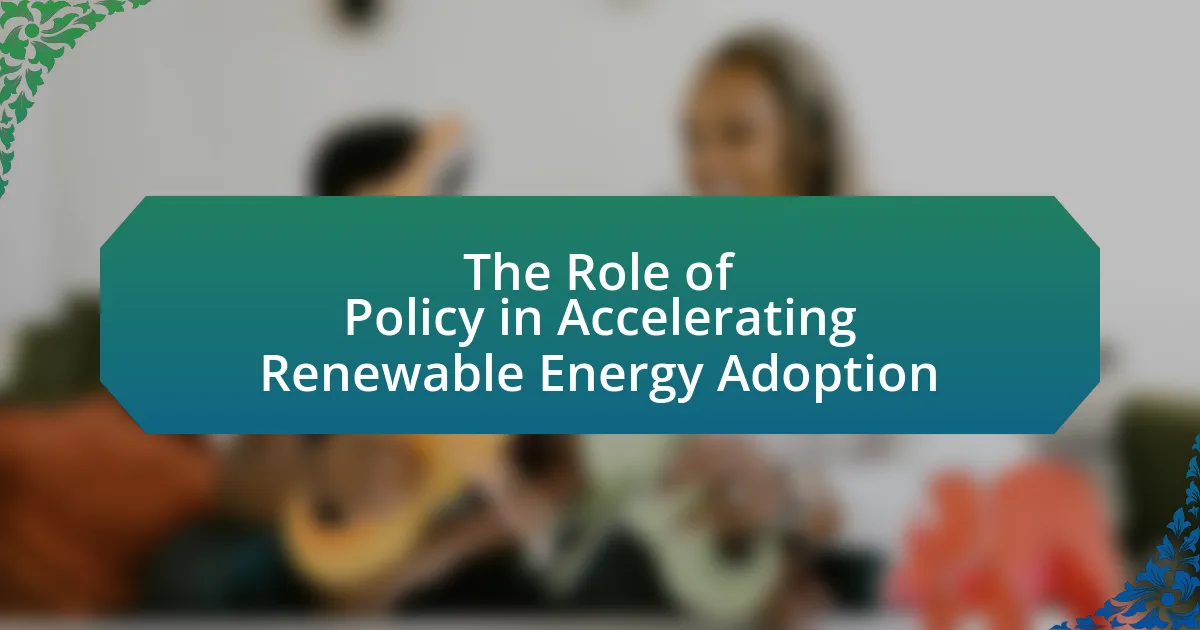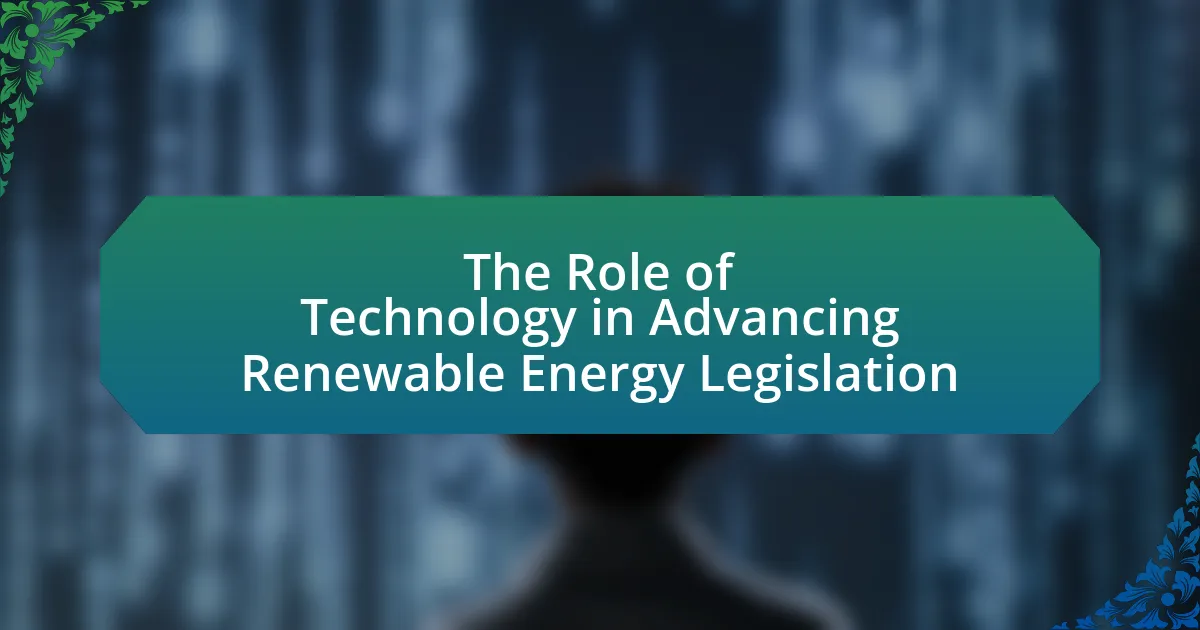Nonprofits play a vital role in shaping renewable energy policy through advocacy, education, and grassroots mobilization. They influence legislation by conducting research, lobbying for favorable policies, and raising public awareness about the benefits of renewable energy. Key organizations, such as the Sierra Club and the Natural Resources Defense Council, have successfully campaigned for significant policies like the Renewable Energy Standard and the Clean Power Plan. Despite facing challenges such as funding limitations and political opposition, nonprofits continue to engage communities and build coalitions to promote sustainable energy initiatives, demonstrating their essential contribution to the transition towards renewable energy solutions.
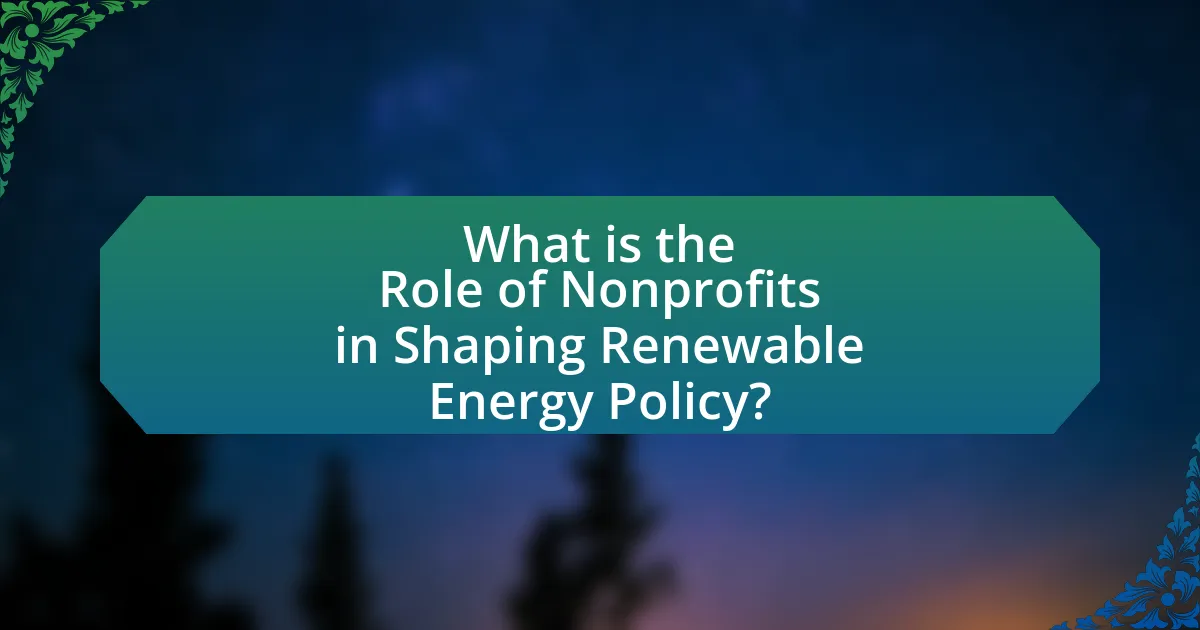
What is the Role of Nonprofits in Shaping Renewable Energy Policy?
Nonprofits play a crucial role in shaping renewable energy policy by advocating for sustainable practices, influencing legislation, and raising public awareness. These organizations often conduct research and provide data that support the transition to renewable energy, which can lead to policy changes at local, state, and national levels. For instance, the Sierra Club has been instrumental in promoting clean energy initiatives and has successfully lobbied for policies that support solar and wind energy development. Additionally, nonprofits engage in grassroots mobilization, educating communities about the benefits of renewable energy, which can drive public support for policy reforms. Their efforts contribute to a more informed electorate that can influence decision-makers in favor of sustainable energy solutions.
How do nonprofits influence renewable energy legislation?
Nonprofits influence renewable energy legislation primarily through advocacy, education, and mobilization of public support. These organizations often engage in lobbying efforts to persuade lawmakers to adopt policies that favor renewable energy initiatives, such as tax incentives or renewable portfolio standards. For instance, the Sierra Club has successfully campaigned for various state-level renewable energy mandates, demonstrating the effectiveness of grassroots mobilization in shaping policy. Additionally, nonprofits conduct research and disseminate information that highlights the benefits of renewable energy, thereby informing both policymakers and the public. This combination of advocacy and education creates a significant impact on legislative outcomes related to renewable energy.
What strategies do nonprofits use to advocate for renewable energy policies?
Nonprofits advocate for renewable energy policies through strategies such as grassroots mobilization, policy research, coalition building, and public awareness campaigns. Grassroots mobilization involves engaging community members to participate in advocacy efforts, which can amplify voices and influence policymakers. Policy research provides data-driven insights that support the case for renewable energy, helping to inform legislative proposals. Coalition building brings together various stakeholders, including businesses, environmental groups, and local governments, to create a unified front that can exert greater influence on policy decisions. Public awareness campaigns educate the public about the benefits of renewable energy, fostering support that can pressure lawmakers to adopt favorable policies. These strategies have been effective in shaping legislation and promoting sustainable energy initiatives across various regions.
How do nonprofits collaborate with government agencies on energy policy?
Nonprofits collaborate with government agencies on energy policy by engaging in advocacy, providing research and data, and facilitating community outreach. These organizations often work to influence policy decisions by presenting evidence-based recommendations that align with public interests, such as sustainability and renewable energy development. For instance, nonprofits like the Natural Resources Defense Council have successfully partnered with government entities to promote clean energy initiatives, demonstrating the effectiveness of collaborative efforts in shaping energy regulations. This partnership is crucial as it combines the expertise of nonprofits with the regulatory power of government agencies, leading to more informed and effective energy policies.
Why are nonprofits important in the renewable energy sector?
Nonprofits are crucial in the renewable energy sector because they drive advocacy, education, and innovation, influencing policy and public perception. These organizations often serve as intermediaries between communities, governments, and the private sector, ensuring that diverse voices are heard in the energy transition. For instance, nonprofits like the Sierra Club have successfully lobbied for renewable energy policies that led to significant increases in solar and wind energy adoption, contributing to a 20% rise in renewable energy generation in the U.S. from 2010 to 2020. Their efforts not only promote sustainable practices but also mobilize public support, making them essential players in shaping a cleaner energy future.
What unique perspectives do nonprofits bring to energy policy discussions?
Nonprofits bring advocacy for social equity and environmental justice to energy policy discussions. They often represent marginalized communities disproportionately affected by energy policies, ensuring that diverse voices are included in the decision-making process. For instance, organizations like the Sierra Club and Greenpeace have historically highlighted the impacts of fossil fuel extraction on low-income neighborhoods, pushing for policies that prioritize renewable energy solutions that are accessible to all. Additionally, nonprofits contribute research and data that emphasize the long-term benefits of sustainable energy practices, influencing policymakers to consider not just economic factors but also social and environmental implications. This multifaceted approach enriches the dialogue around energy policy, promoting a more holistic understanding of the issues at hand.
How do nonprofits address gaps in renewable energy advocacy?
Nonprofits address gaps in renewable energy advocacy by conducting research, raising public awareness, and influencing policy through grassroots mobilization. These organizations often identify specific areas where advocacy is lacking, such as community engagement or education on renewable technologies. For instance, the Sierra Club has successfully campaigned for renewable energy policies by mobilizing local communities and providing them with resources to advocate for clean energy solutions. Additionally, nonprofits like the Renewable Energy Policy Project analyze data to highlight the economic benefits of renewable energy, thereby filling knowledge gaps that hinder effective advocacy. This targeted approach enables nonprofits to effectively bridge the divide between public understanding and policy implementation in the renewable energy sector.
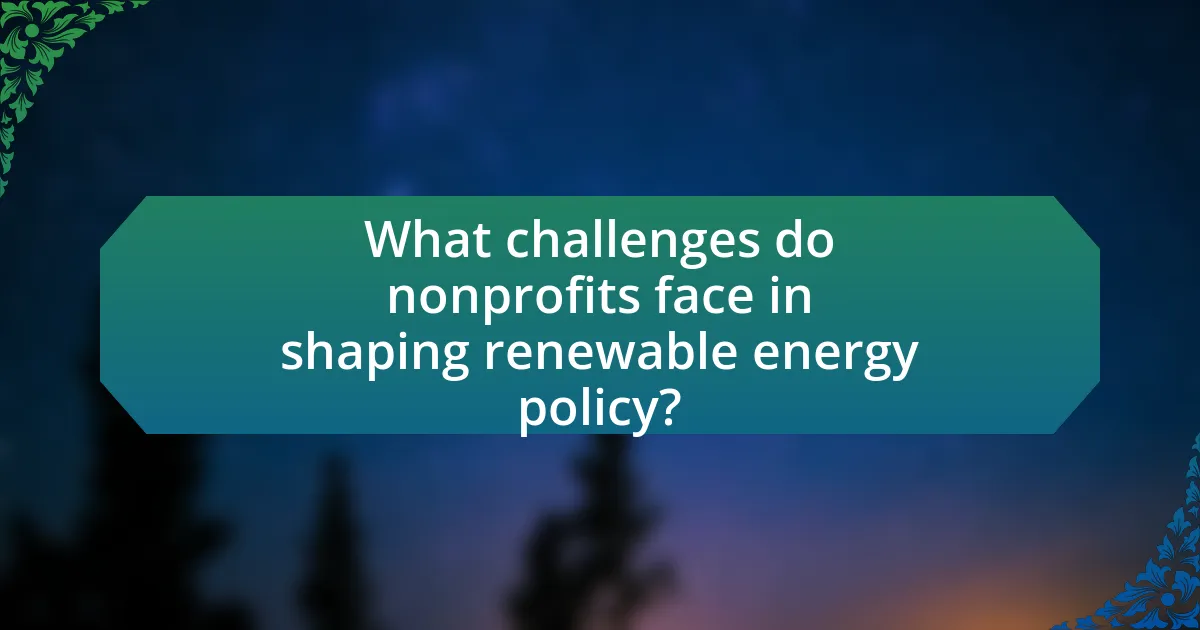
What challenges do nonprofits face in shaping renewable energy policy?
Nonprofits face significant challenges in shaping renewable energy policy, primarily due to limited funding and resources. Many nonprofits operate on tight budgets, which restricts their ability to conduct extensive research, engage in lobbying efforts, or mobilize grassroots campaigns effectively. Additionally, they often encounter political resistance from established energy interests that may oppose renewable initiatives, making it difficult to influence policymakers. For instance, a report by the National Council of Nonprofits highlights that nonprofits frequently struggle to compete with well-funded lobbying groups representing fossil fuel industries, which can dominate the policy discourse. Furthermore, the complexity of energy regulations and the need for technical expertise can hinder nonprofits’ ability to advocate effectively for renewable energy solutions.
How do funding limitations impact nonprofit advocacy efforts?
Funding limitations significantly hinder nonprofit advocacy efforts by restricting their ability to conduct outreach, mobilize resources, and implement programs. Nonprofits often rely on grants and donations to fund their initiatives; when these financial resources are limited, their capacity to influence policy and engage stakeholders diminishes. For instance, a study by the National Council of Nonprofits found that 70% of nonprofits reported that funding constraints negatively affected their ability to advocate effectively for policy changes. This lack of funding can lead to reduced staffing, limited campaign activities, and decreased public engagement, ultimately weakening their impact on renewable energy policy advocacy.
What are the implications of reduced funding on nonprofit initiatives?
Reduced funding significantly hampers nonprofit initiatives, leading to diminished program effectiveness and outreach. Nonprofits often rely on financial resources to implement projects, hire staff, and maintain operations; thus, a decrease in funding can result in program cuts, layoffs, and reduced services. For instance, a study by the Urban Institute found that 70% of nonprofits reported a decline in funding, which directly correlated with a reduction in services offered to communities. This financial strain can also limit advocacy efforts, as nonprofits play a crucial role in shaping policies, including those related to renewable energy. Without adequate funding, their ability to influence legislation and mobilize community support for sustainable initiatives is severely compromised.
How can nonprofits overcome financial challenges in policy advocacy?
Nonprofits can overcome financial challenges in policy advocacy by diversifying their funding sources and building strategic partnerships. Diversification allows nonprofits to reduce reliance on a single funding stream, which can be risky; for instance, organizations that secure funding from multiple grants, individual donations, and corporate sponsorships are better positioned to weather financial fluctuations. Strategic partnerships with other organizations, businesses, or government entities can also provide additional resources and shared funding opportunities, enhancing the capacity for effective advocacy. According to a report by the National Council of Nonprofits, nonprofits that engage in collaborative efforts often experience increased funding and resource sharing, which can significantly bolster their advocacy initiatives.
What political obstacles do nonprofits encounter?
Nonprofits encounter several political obstacles, including regulatory challenges, funding limitations, and opposition from vested interests. Regulatory challenges arise when nonprofits face complex compliance requirements that can hinder their ability to operate effectively. Funding limitations often stem from political decisions that affect grant availability and tax incentives, which can restrict nonprofits’ financial resources. Additionally, opposition from vested interests, such as corporations or political groups that may be threatened by the advocacy efforts of nonprofits, can lead to lobbying against their initiatives. These obstacles can significantly impact the ability of nonprofits to influence renewable energy policy effectively.
How do changes in government affect nonprofit influence on energy policy?
Changes in government significantly affect nonprofit influence on energy policy by altering funding priorities, regulatory frameworks, and political alliances. For instance, when a government shifts towards more environmentally focused leadership, nonprofits often gain increased access to funding and support for renewable energy initiatives, as seen during the Obama administration, which prioritized clean energy investments. Conversely, a government that favors fossil fuels may restrict nonprofit activities and funding, as observed during the Trump administration, where many environmental nonprofits faced challenges in advocating for renewable energy policies due to reduced federal support and regulatory rollbacks. These shifts directly impact the ability of nonprofits to shape energy policy, as their influence is closely tied to the political climate and government priorities.
What strategies can nonprofits employ to navigate political challenges?
Nonprofits can navigate political challenges by engaging in strategic advocacy, building coalitions, and leveraging data-driven narratives. Strategic advocacy involves identifying key policymakers and tailoring messages that resonate with their interests, which can influence legislative outcomes. Building coalitions with other organizations amplifies their voice and resources, enhancing their ability to effect change. Additionally, utilizing data-driven narratives allows nonprofits to present compelling evidence that supports their positions, making their arguments more persuasive. For instance, a study by the National Council of Nonprofits highlights that nonprofits that effectively use data in their advocacy efforts are more likely to achieve favorable policy outcomes.
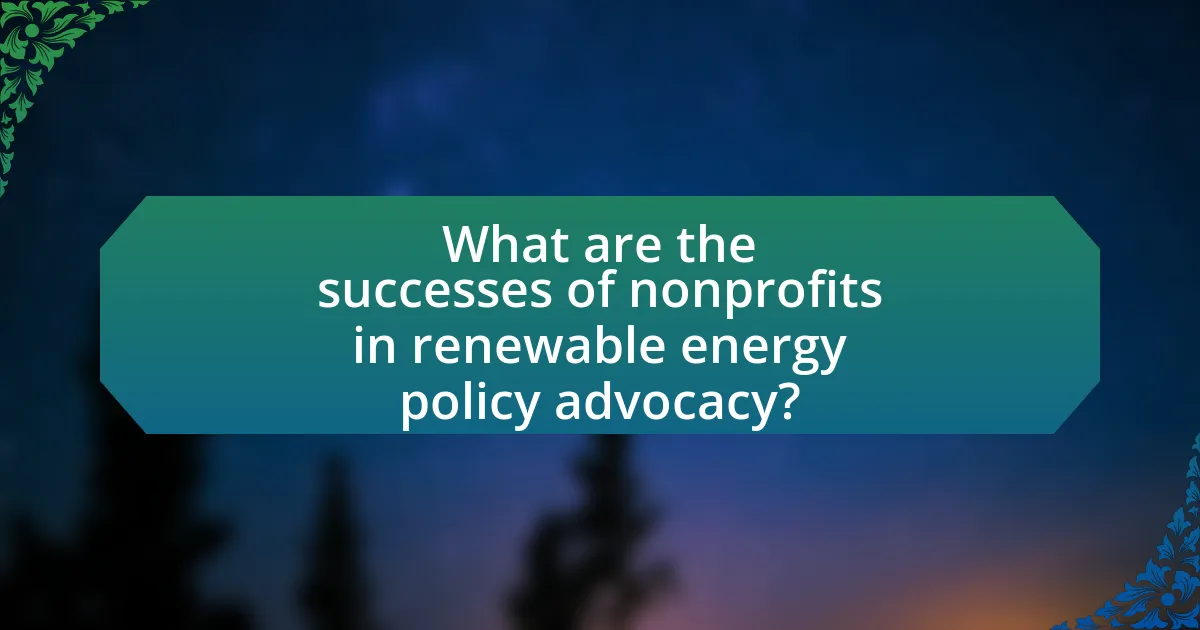
What are the successes of nonprofits in renewable energy policy advocacy?
Nonprofits have successfully influenced renewable energy policy advocacy by driving legislative changes and increasing public awareness. For instance, organizations like the Sierra Club have played a pivotal role in the adoption of renewable energy standards in various states, leading to a significant increase in renewable energy generation. According to a report by the National Renewable Energy Laboratory, states with strong nonprofit advocacy have seen renewable energy capacity grow by over 50% in the last decade. Additionally, nonprofits have successfully mobilized grassroots campaigns that resulted in the passage of key legislation, such as the Clean Power Plan, which aimed to reduce carbon emissions from power plants. These efforts demonstrate the effectiveness of nonprofits in shaping policies that promote renewable energy initiatives.
What notable policies have been influenced by nonprofit organizations?
Nonprofit organizations have significantly influenced notable policies such as the Renewable Energy Standard (RES) and the Clean Power Plan in the United States. The RES, which mandates a certain percentage of energy to come from renewable sources, was shaped by advocacy from nonprofits like the Sierra Club and the Natural Resources Defense Council, which highlighted the environmental and economic benefits of renewable energy. Similarly, the Clean Power Plan, aimed at reducing carbon emissions from power plants, was influenced by extensive research and lobbying from organizations such as the Environmental Defense Fund, which provided data on the health impacts of pollution and the feasibility of transitioning to cleaner energy sources. These examples demonstrate the critical role nonprofits play in shaping energy policies that promote sustainability and environmental protection.
How have specific nonprofits contributed to landmark renewable energy legislation?
Specific nonprofits have significantly influenced landmark renewable energy legislation by advocating for policy changes, conducting research, and mobilizing public support. For instance, the Sierra Club played a crucial role in the passage of the Clean Power Plan in 2015 by organizing grassroots campaigns that emphasized the need for reducing carbon emissions from power plants. Additionally, the Natural Resources Defense Council (NRDC) contributed by providing legal expertise and scientific research that informed lawmakers about the benefits of renewable energy sources. These actions demonstrate how nonprofits leverage their resources and networks to shape effective renewable energy policies.
What metrics can be used to measure the success of nonprofit advocacy?
Metrics used to measure the success of nonprofit advocacy include policy changes, public awareness levels, stakeholder engagement, and funding increases. Policy changes can be quantified by tracking the number of legislative or regulatory actions influenced by advocacy efforts. Public awareness levels can be assessed through surveys measuring changes in public opinion or knowledge regarding renewable energy issues. Stakeholder engagement can be evaluated by the number of partnerships formed or the level of participation in advocacy campaigns. Funding increases can be measured by the growth in donations or grants received as a direct result of advocacy activities. These metrics provide concrete evidence of the impact and effectiveness of nonprofit advocacy in shaping renewable energy policy.
How do nonprofits engage communities in renewable energy initiatives?
Nonprofits engage communities in renewable energy initiatives by facilitating education, providing resources, and fostering collaboration among stakeholders. They conduct workshops and informational sessions to raise awareness about renewable energy benefits, such as cost savings and environmental impact. For example, organizations like the Sierra Club have successfully mobilized community members to advocate for local solar energy projects, demonstrating the effectiveness of grassroots engagement. Additionally, nonprofits often partner with local governments and businesses to create funding opportunities, making renewable energy projects more accessible. This collaborative approach not only empowers communities but also enhances the overall effectiveness of renewable energy initiatives.
What role do grassroots movements play in shaping energy policy?
Grassroots movements play a crucial role in shaping energy policy by mobilizing community support and advocating for sustainable practices. These movements often raise awareness about environmental issues, influencing public opinion and pressuring policymakers to adopt renewable energy initiatives. For instance, the Sierra Club’s “Beyond Coal” campaign successfully led to the closure of numerous coal plants in the United States, demonstrating how grassroots advocacy can directly impact energy policy decisions. Additionally, grassroots organizations frequently engage in lobbying efforts, providing a platform for local voices to be heard in legislative processes, thereby ensuring that energy policies reflect community needs and priorities.
How can nonprofits effectively mobilize community support for renewable energy?
Nonprofits can effectively mobilize community support for renewable energy by engaging in education and outreach initiatives that raise awareness about the benefits of renewable energy sources. For instance, studies show that community-based programs that provide information on energy efficiency and renewable options can increase public support by up to 70%. Additionally, nonprofits can foster partnerships with local businesses and government entities to create collaborative projects that demonstrate the feasibility and advantages of renewable energy, thereby building trust and credibility within the community. By organizing events, workshops, and campaigns that highlight local success stories, nonprofits can inspire community members to take action and advocate for renewable energy policies.
What best practices can nonprofits adopt for effective advocacy?
Nonprofits can adopt several best practices for effective advocacy, including building strong coalitions, utilizing data-driven strategies, and engaging in grassroots mobilization. Strong coalitions enhance influence by uniting diverse stakeholders, which can amplify the voice of the nonprofit and increase its reach. Data-driven strategies, such as leveraging research and statistics, provide credible evidence to support advocacy efforts, making arguments more persuasive. Grassroots mobilization encourages community involvement, fostering a sense of ownership and urgency around the issues at hand. For instance, a study by the National Council of Nonprofits highlights that organizations that effectively mobilize grassroots support can significantly impact policy decisions, demonstrating the power of community engagement in advocacy efforts.
How can nonprofits build coalitions to strengthen their advocacy efforts?
Nonprofits can build coalitions to strengthen their advocacy efforts by identifying common goals with other organizations and fostering collaborative relationships. This approach allows nonprofits to pool resources, share expertise, and amplify their collective voice on renewable energy policy issues. For instance, the Coalition for Renewable Energy and Economic Development successfully united various stakeholders to advocate for clean energy legislation, demonstrating that collaboration can lead to significant policy changes. By leveraging shared interests and aligning strategies, nonprofits can enhance their influence and effectiveness in shaping renewable energy policies.
What communication strategies are most effective for nonprofits in energy policy advocacy?
Effective communication strategies for nonprofits in energy policy advocacy include storytelling, data-driven messaging, and coalition building. Storytelling engages audiences emotionally, making complex energy issues relatable and memorable. Data-driven messaging provides credible evidence to support policy positions, enhancing the organization’s authority and trustworthiness. Coalition building fosters partnerships with other organizations, amplifying the advocacy message and increasing influence. Research shows that nonprofits employing these strategies can significantly enhance their impact on energy policy discussions and outcomes. For instance, a study by the Center for American Progress found that organizations using storytelling in their campaigns saw a 30% increase in public engagement compared to those relying solely on traditional messaging.
